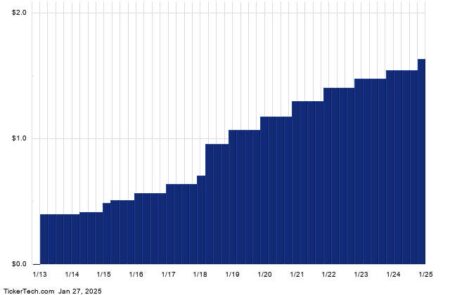While hot tech and social media stocks like Amazon and Meta Platforms continue to make new highs, there is one sector failing to keep up: restaurant stocks. Some of these names — like McDonalds — used to be considered must-owns for portfolio managers looking to outperform the averages.
Judging by these price charts, those days may be over.
5 Restaurant Stocks In Recent Decline.
Arcos Dorados Holdings (Nasdaq: ARCO):
The price in mid-December dropped below the mid-September support where the red-dotted line is placed. The 50-day moving average in May crossed below the 200-day moving average. The stock briefly rallied off of the late year low but remains below both of those moving averages.
Arcos Dorados trades with a price-earnings ratio of 10.57 and at 3 times its book value. The debt-to-equity ratio is 3.35. This year’s earnings are off by 26%. Over the past five years, EPS shows growth of 37%. The company pays a 3.41% dividend.
McDonalds (NYSE: MCD):
The price in mid-January dipped below the 200-day moving average and has since rallied a bit, although it remains below a down-trending 50-day moving average. That dip down broke below the November low, a previous level of buying support, indicated by the red-dotted line.
The company, one of the most recognized brand names in the world, has a market cap of $204 billion. It trades with a price-earnings ratio of 25. Earnings this year are off by 1.36% and up over the past five years by 8.93%. McDonald’s pays a dividend of 2.37%.
Restaurant Brands International (NYSE: QSR):
The price in early January broke below the previous support level from late May of $54. The stock has rallied off of the mid-month low of $50 and the buying volume looks strong. The 50-day moving average in early June crossed below the 200-day moving average and it’s never gone back above it.
Restaurant Brands includes the franchises Burger King, Tim Hortons, Popeyes and Firehouse Subs. Market cap is $20.10 billion. The price-earnings ratio is 15. The debt-to-equity ratio is on the high side at 4.94. The company offers investors a 3.75% dividend.
Wendy’s (Nasdaq: WEN):
Last week’s new low takes the price well below the July low, the previous level of buying support. The stock participated in the post-election rally and then began a steady descent in value. The 50-day moving average in mid-January crossed below the 200-day moving average, a clear signal of weakness.
Market capitalization is $2.91 billion. The price-earnings ratio is 15. The debt-to-equity ratio is a steep 15. This year’s earnings are up by 2.85%. EPS growth over the past five years is 10%. The short float of 6.56% indicates a greater interest among short sellers than the other similar brands listed here.
Yum Brands (NYSE: YUM):
The mid-January low briefly took the price below the late July low. The stock found buyers at $122 and rallied back to just above $129. The 50-day moving average last week crossed below the 200-day moving average.
Yum Brands operates more than 59,000 restaurants in over 150 countries and territories, according to the company website. Market cap is $35.79 billion. The price-earnings ratio is 23.99. Earnings this year are up by 5.87% and up over the past five years by 3.62%. Yum pays a 2.08% dividend.
Stats courtesy of FinViz.com. Charts courtesy of Stockcharts.com.
More analysis and commentary at johnnavin.substack.com.
Read the full article here
















